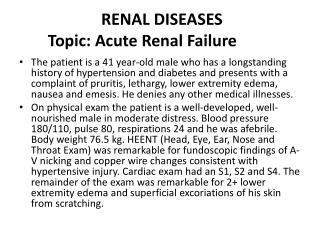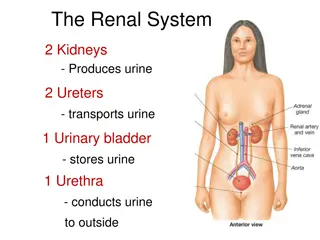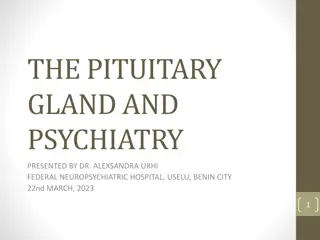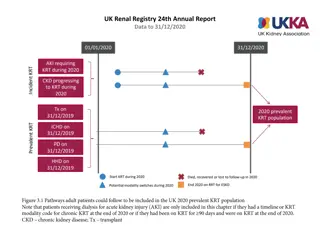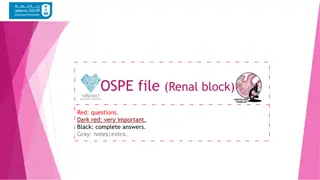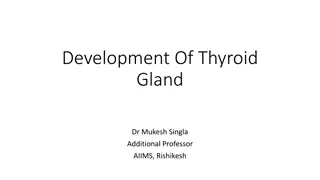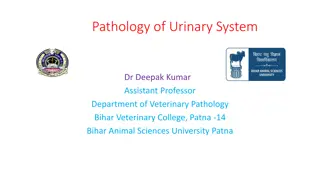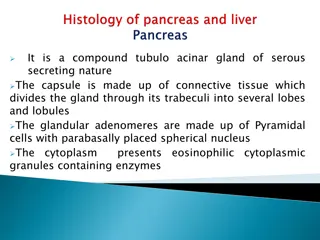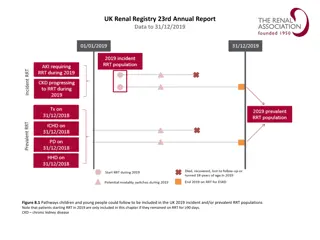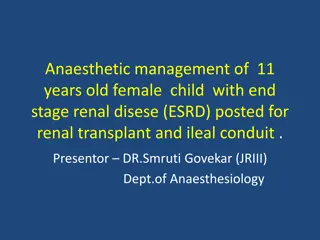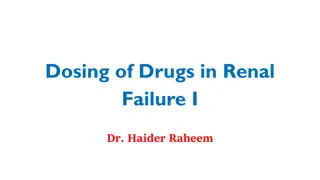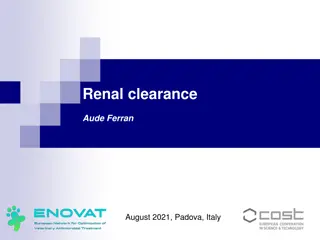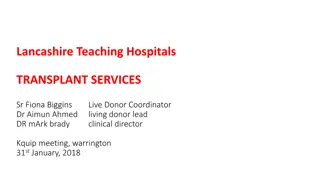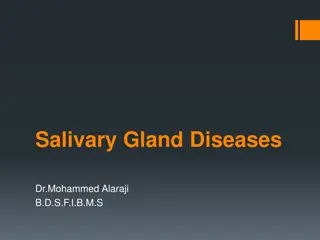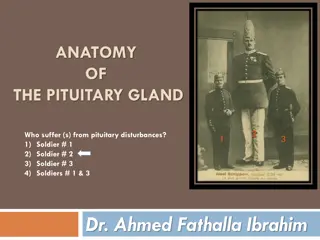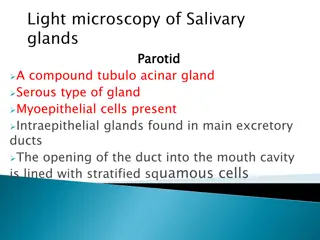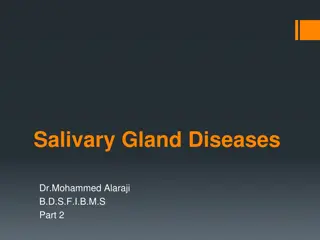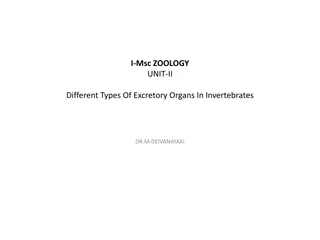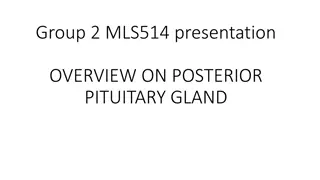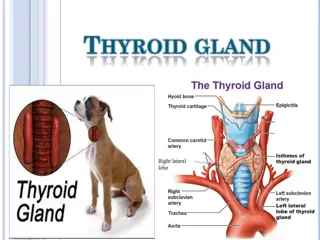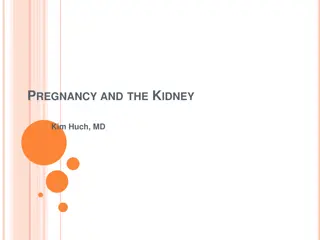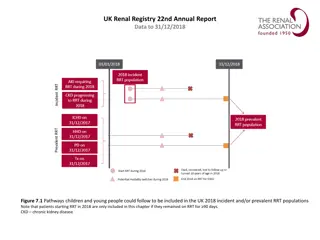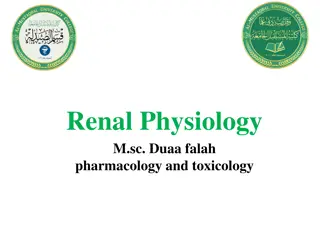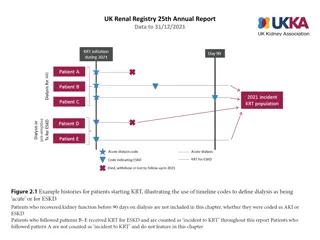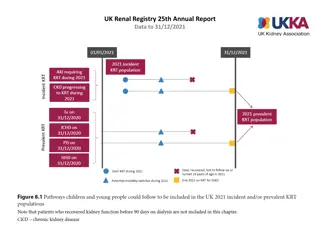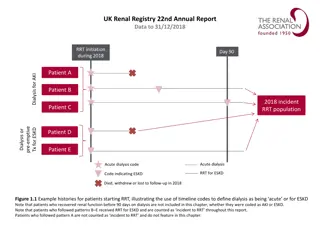RENAL DISEASES - Topic: Acute Renal Failure
Discusses a case of acute renal failure in a 41-year-old male with a history of hypertension and diabetes. It covers the patient's symptoms, laboratory data, and possible causes.
1 views • 14 slides
Abbott Nepro LP Powder Optimal Renal Nutrition for Individuals
Abbott Nepro LP Powder Vanilla Toffe - Complete Renal Nutrition Carb Steady Lower Protein (400 GMS) For People With Kidney Disease (Non-DIALYZED)\n\nEssential Support: Abbott Nepro LP Powder For Renal Nutrition\n\nExperience Essential Support For Individuals With Kidney Disease Through Abbott Nepro
1 views • 4 slides
An Overview of the Renal System and Nephron Anatomy
The renal system consists of the kidneys, ureters, urinary bladder, and urethra, responsible for producing, transporting, storing, and excreting urine. The kidneys are surrounded by three layers, and the nephron is the functional unit responsible for filtering blood and producing urine. Key componen
4 views • 26 slides
Understanding Renal Function Tests: Lecture Insights on Kidney Function and Structure
This lecture delves into the essential aspects of renal function tests, exploring the functional units of the kidney, the role of nephrons in maintaining homeostasis, and the intricate processes of filtration, reabsorption, and secretion within the renal tubules. Key topics include the hormonal and
4 views • 17 slides
SALIVARY GLAND IMAGING
Salivary gland imaging plays a crucial role in diagnosing and monitoring diseases of the major salivary glands, including the parotid, submandibular, and sublingual glands. Different imaging techniques such as computed tomography, MRI, and ultrasound are used to visualize these glands and aid in dif
1 views • 12 slides
Adrenal Gland
This content delves into the detailed structure and function of the adrenal gland, focusing on the differentiation between the cortex and medulla, the histological features of each zone, and the hormones produced. From the distinction of various cortical layers to the role of chromaffin cells in the
0 views • 8 slides
Understanding the Thyroid Gland: Functions and Hormone Synthesis
The thyroid gland is a vital endocrine gland located below the larynx, responsible for producing thyroid hormones essential for regulating metabolism. This gland consists of follicles lined with follicular cells, producing thyroglobulin and thyroid hormones T3 and T4. Iodine plays a crucial role in
0 views • 40 slides
Understanding the Pituitary Gland: Implications in Psychiatry
This presentation by Dr. Alexsandra Urhi delves into the anatomy, function, and psychiatric implications of the pituitary gland. It explores the interplay between endocrine structures, the CNS, and psychotropic drugs' effects on the pituitary gland.
0 views • 35 slides
Renal Pharmacology: Drug Excretion and Renal Clearance Questions
This comprehensive set of questions and answers covers topics related to drug excretion and renal pharmacology. It includes information on glomerular filtration, drug excretion mechanisms, dosage adjustments in renal impairment, factors influencing drug excretion, and the effects of long-term NSAID
0 views • 55 slides
UK Renal Registry 24th Annual Report Data Summary 2020
The UK Renal Registry's 24th Annual Report provides comprehensive data and insights on renal health in the UK up to 31st December 2020. The report covers various aspects such as patient outcomes, treatment trends, and demographic characteristics, highlighting the challenges and progress in the manag
4 views • 16 slides
Renal Block Pathology Practical: Anatomy and Histology Overview
The Renal Block Pathology Practical provides a comprehensive insight into the anatomy, structure, and histology of the kidney nephrons, including normal and abnormal conditions such as acute kidney injury. The session covers topics like the structure of the nephron, normal kidney gross anatomy, rena
3 views • 47 slides
Overview of Pituitary Gland: Structure, Function, and Relationships
The pituitary gland, also known as the hypophysis, is an endocrine gland located at the base of the brain. It is divided into two main parts: the adenohypophysis and the neurohypophysis. The gland plays a crucial role in hormone regulation and is closely related to neighboring structures such as the
0 views • 26 slides
Histology of the Renal System for OSPE Exam Preparation
This comprehensive OSPE file for renal block covers key structures of the kidney including the cortex, juxtaglomerular apparatus, renal corpuscle, and kidney medulla. It provides detailed identification of structures, labeling of components, and differentiation between tubules. Helpful images and de
0 views • 11 slides
Understanding Renal Block: Drugs, Excretion, and Treatment Essentials
Renal block plays a crucial role in drug excretion, with processes like glomerular filtration and tubular secretion affecting drug elimination. Factors like blood flow, physiochemical properties, and urine pH influence renal excretion of drugs. Competition between drugs for transporters can have ben
0 views • 10 slides
Development of Thyroid Gland in Embryonic Stage
The thyroid gland is the first endocrine gland to develop in the human body, starting from a median endodermal thickening in the primitive pharynx. The process involves the descent of the thyroid diverticulum and formation of lobes by week 7 of embryonic development. The thyroid gland begins functio
0 views • 24 slides
Anomalies of Kidneys and Factors Affecting Renal Function in Veterinary Pathology
An overview of anomalies affecting the kidneys in animals, including ectopic kidney location, renal agenesis, renal aplasia, and renal hypoplasia. The images illustrate anomalies such as fused kidneys and duplication of kidneys, with explanations of occurrence and sequelae. Additionally, factors aff
0 views • 13 slides
Understanding the Microscopic Structure and Function of the Pituitary Gland
Explore the detailed histology of the pituitary gland, focusing on its adenohypophysis and neurohypophysis components. Learn about the diverse parenchymal cells, including acidophils, basophils, and chromophobes, and their respective functions in hormone production. Dive into the significance of the
0 views • 6 slides
Structure and Function of a Serous Compound Tubulo-acinar Gland
A detailed description of a compound tubulo-acinar gland with serous-secreting nature is provided, highlighting its cellular composition, arrangement of ducts, and connective tissue organization. The glandular structure, including adenomeres, centroacinar cells, and myoepithelial cells, is discussed
0 views • 15 slides
UK Renal Registry 23rd Annual Report Data Summary 2019
The UK Renal Registry 23rd Annual Report Data for the year 2019 provides detailed insights into the pathways, modalities, and primary renal diseases affecting children and young people (<16 years old) requiring renal replacement therapy (RRT). The report includes figures on RRT modalities, compariso
0 views • 17 slides
Anaesthetic Management of 11-Year-Old Female with End-Stage Renal Disease (ESRD) for Renal Transplant and Ileal Conduit
An 11-year-old female child with end-stage renal disease (ESRD) and multiple surgical histories was evaluated for renal transplant and ileal conduit surgery. The patient presented with hypertension, chronic kidney disease, neurogenic bladder, and urinary incontinence. Preoperative assessments reveal
0 views • 22 slides
Ceftazidime Dosage Modification in Renal Failure Cases
Ceftazidime dosage adjustments are crucial in patients with renal impairment to prevent toxicity or suboptimal treatment. Factors like renal function, drug elimination route, and therapeutic window must be considered. Proper dosing ensures effective treatment while avoiding adverse effects in patien
0 views • 33 slides
Understanding Renal Clearance and its Physiological Mechanisms
This content delves into the concept of renal clearance, exploring its relation to lipophilicity and mechanisms such as glomerular filtration, tubular secretion, and reabsorption. The processes occurring at the nephron level and the vascularization scheme are detailed, along with a breakdown of phys
0 views • 31 slides
UK Renal Registry 24th Annual Report Data Summary 2020
The UK Renal Registry 24th Annual Report Data provides comprehensive insights into renal health and patient outcomes up to 31/12/2020. The report covers a wide range of data including treatment trends, patient demographics, transplant outcomes, and more. It serves as a valuable resource for healthca
0 views • 16 slides
Lancashire Teaching Hospitals Renal Transplant Services Overview
Lancashire Teaching Hospitals' Renal Transplant Services led by Sr. Fiona Biggins and Dr. Aimun Ahmed serve a population of 1.6 million, with key areas of focus including living kidney donation, renal services across Lancashire and South Cumbria, quality improvement initiatives, and lean improvement
1 views • 13 slides
Comprehensive Overview of Salivary Gland Diseases and Management
Salivary gland diseases encompass various conditions affecting the salivary glands, including developmental abnormalities, inflammatory and non-inflammatory enlargement, cysts, tumors, and dysfunction. Investigations such as plain films, sialography, MRI, and biopsies are essential for diagnosis. Si
0 views • 49 slides
Understanding the Pituitary Gland: Anatomy, Functions, and Disorders
The pituitary gland, also known as the master endocrine gland, plays a crucial role in regulating various hormonal functions in the body. Learn about its anatomy, position, subdivisions, important relations, and common disturbances. Explore how soldiers and individuals like them can be affected by p
0 views • 17 slides
Overview of Salivary Glands Structure
Salivary glands play a crucial role in the production and secretion of saliva, aiding in digestion and oral health. The parotid gland is a compound tubuloacinar gland with serous characteristics, while the sublingual gland is a seromucous type. Minor salivary glands, found in carnivores, vary in com
0 views • 16 slides
Overview of Salivary Gland Tumors and Diseases
Salivary gland diseases, including tumors, can affect both major and minor glands. These tumors may be benign or malignant, with common benign tumors like pleomorphic adenoma. Clinical features of salivary gland tumors vary, with slow-growing benign tumors being more common. Pleomorphic adenoma is p
0 views • 27 slides
Overview of Different Excretory Organs in Invertebrates
In invertebrates, there are various types of excretory organs such as the contractile vacuole, nephridium, renal gland, coxal gland, and Malpighian tubule. These organs play crucial roles in osmotic regulation and nitrogen excretion. Different phyla exhibit diverse excretory structures like nephridi
0 views • 6 slides
Understanding the Posterior Pituitary Gland and Its Hormones
The posterior pituitary gland, a key part of the endocrine system, plays a vital role in hormone secretion. It controls the release of oxytocin and vasopressin, influencing social bonding, reproduction, and childbirth. Learn about the anatomy, function, and disorders associated with this important g
0 views • 26 slides
Understanding the Thyroid Gland: Structure, Hormones, and Function
The thyroid gland, a butterfly-shaped structure located on the ventral surface of the trachea, secretes hormones essential for regulating metabolic rate, growth, and development. It produces hormones like Tetraiodothyronine T4, Triiodothyronine T3, and Calcitonin, which play crucial roles in maintai
0 views • 21 slides
Renal Function Monitoring in the PROUD Study: Truvada Pre-Exposure Prophylaxis Trial
Renal function in the PROUD study, a pragmatic open-label randomized trial of Truvada as pre-exposure prophylaxis, was monitored closely. No significant safety concerns were found, with similar renal adverse events between the placebo and Truvada groups. Regular monitoring included baseline serum cr
0 views • 16 slides
UK Renal Registry 24th Annual Report Data Summary 2020
The UK Renal Registry's 24th Annual Report provides comprehensive data and analysis up to 31st December 2020, covering various aspects related to renal health in the UK. The report highlights key findings, trends, and outcomes in renal care, including information on treatments, patient demographics,
0 views • 13 slides
Overview of Renal Tumors: Benign and Malignant Forms
Explore the spectrum of renal tumors, from benign papillary adenomas and oncocytomas to malignant renal cell carcinomas like clear cell carcinoma. Images and descriptions showcase the gross pathology and histopathology of these tumors. Learn about the features and prognosis of different renal tumor
0 views • 31 slides
Pregnancy and the Kidney: Physiological Changes and Considerations for Chronic Kidney Disease
GB, a 28-year-old woman with a history of FSGS, seeks advice on pregnancy. Physiological changes in pregnancy affect renal function, including increased renal flow and volume, ureteral dilation, and systemic vasodilation. Renal hemodynamics peak in the first trimester without causing kidney damage.
0 views • 36 slides
UK Renal Registry 22nd Annual Report Data (2018): Pediatric Renal Disease Insights
The UK Renal Registry's 22nd Annual Report presents detailed data on pathways and modalities for pediatric patients with chronic kidney disease. Figures from the report highlight the start of renal replacement therapy (RRT), prevalent RRT modalities, primary renal diseases, z-scores for height, and
0 views • 17 slides
Understanding Renal Physiology and Functions
This content covers the aims of studying renal physiology, functions of the kidney, basic renal processes, renal secretion, urine formation, and types of renal failure. It delves into topics such as water balance, electrolyte balance, urine production, and the components of the urinary system. The i
0 views • 10 slides
UK Renal Registry 25th Annual Report Data Summary
The UK Renal Registry's 25th Annual Report Data up to 31/12/2021 provides valuable insights into renal health statistics and trends in the UK. The report covers various aspects of renal care, including patient outcomes, treatment modalities, and demographic information. It serves as a comprehensive
0 views • 25 slides
UK Renal Registry 25th Annual Report Data Summary for 2021
The UK Renal Registry's 25th Annual Report provides comprehensive data and insights on renal health up to 31st December 2021. The report covers various aspects such as prevalence, incidence, treatment modalities, and outcomes related to renal diseases in the UK population. It offers valuable informa
0 views • 16 slides
UK Renal Registry 22nd Annual Report Data (2018)
The UK Renal Registry's 22nd Annual Report Data to 31/12/2018 provides detailed insights into various aspects of renal replacement therapy (RRT) initiation, incidence rates, primary renal diseases, RRT modalities, and more. The report includes figures illustrating RRT initiation patterns, adult RRT
0 views • 32 slides
